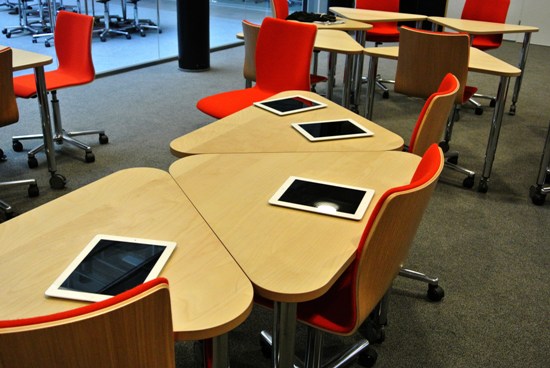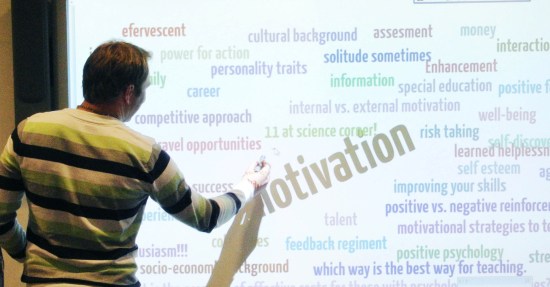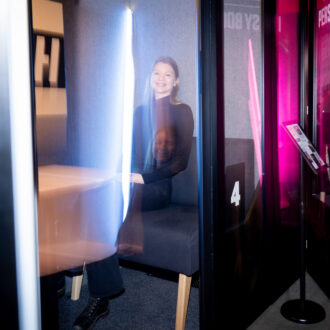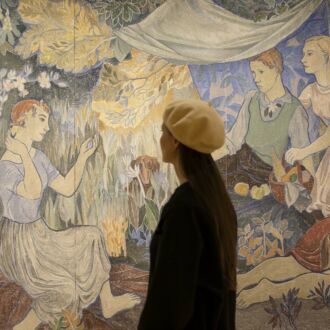Engaging Learning Environment, a project that forms part of Helsinki’s year as 2012 World Design Capital, presents learning methods and environments of the future, combining new technology and teaching.
The idea of the project is to use active and engaging learning methods, instead of basic lecturing and listening. Technology plays an important part here, supporting teaching and learning through an active, hands-on approach.
One of the main figures behind this project is University of Helsinki professor of educational psychology Kirsti Lonka. “We began to develop active learning methods in the 1980s,” she says. “The physical space and technology don’t really solve anything. It’s the pedagogical idea that matters. The emphasis is on students, student-activity, structuring and receiving information.”
Living and learning lab

Smartphones, iPads and other technology are all part of a typical day in the learning lab.Photo: Annika Rautakoura
Minerva Plaza, a learning lab located in the facilities of the Faculty of Behavioural Sciences at the university, is a learning environment that has been transformed into an architecturally innovative space. It implements technology in larger and smaller spaces for groups of different sizes and various types of events.
“This is a learning environment of the future for teachers and students, so they can take the conventions to schools,” says project manager Oskari Salmi. “The idea is not to get ahead of technology, but teach teachers to utilise it as well. What’s important here is the transformability of the space; other methods can be also used here, such as drama.”
The lab contains 12 iPads and 12 Nokia Lumia smartphones configured for use in this space. They utilise Flinga, an app from Finnish startup Nordtouch that enables you to connect mobile devices and classroom teaching aids. Images may be viewed on all screens in Minerva Plaza, including those in the smaller rooms, and everyone may edit the content. The devices allow the student to become involved by editing the same document that everyone sees.
In one exercise, students introduce themselves by sending pictures of each other from iPads to the big main screen, then organising the photos, matching them with names. Students can also use iPads to associate colours with certain activities to indicate motivation.
Experimenting with future teaching methods

Lauri Vaara, one of the hosts of Minerva Plaza, moves terms around on the screen during a learning sessionPhoto: Annika Rautakoura
“It’s a space where you can safely experiment with new and different procedures,” says Lauri Vaara, a student of educational psychology and one of the hosts of Minerva Plaza. “Whatever can be found here can be incorporated into teaching at the university, comprehensive school and upper secondary levels, as well as company training. It is challenging to develop activating lectures and teaching methods, to find out how we can make use of technology and how new technology supports new pedagogical scripts.”
Currently the lab is used by the Departments of Teacher Education and Behavioural Sciences for educational purposes. The aim is to host outside events too, such as company training events, when the university is not using it.
Learning spaces can be divided and merged, and the spaces are completely soundproof. A huge glass wall enables visibility, a crucial aspect of active learning. “In this environment you can practice what it feels like when someone sees what you are doing,” says Vaara.
Lonka calls the space neofunctionalistic: “It should be beautiful and user-friendly, inspiring. It is a place where people gather and share their enthusiasm.”
Even after Helsinki’s year as World Design Capital ends, the lessons of the Engaging Learning Environment are being carried forward, and Minerva Plaza will continue to exist as a learning environment. The project is a part of RYM-SHOK, a strategic centre for science, technology and innovation in built environments, and will continue its development as a living lab under the RYM Indoor Environment Programme.
Living labs are paving the way for permanent innovative learning environments of the future. With technology and educational research advancing, these environments may be turn out to look quite different.
By Annika Rautakoura, November 2012



